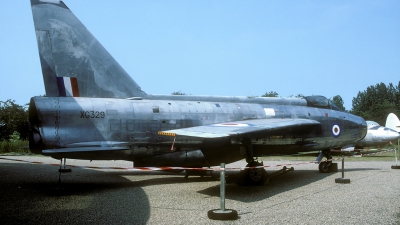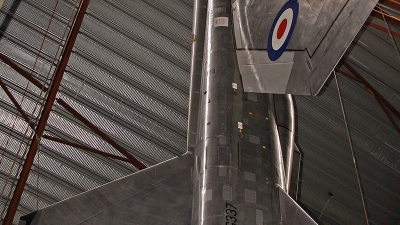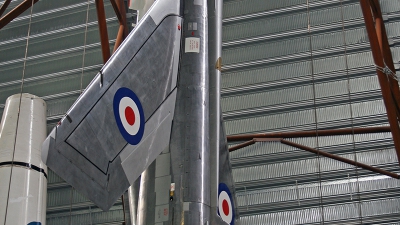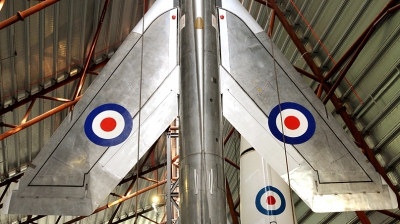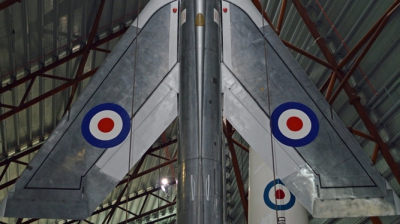English Electric Lightning P1B Aircraft Data
As it turned out the unconventional English Electric Lightning became the first and last all-British supersonic interceptor jet of the Royal Air Force. It was unconventional in that its powerful twin Rolls Royce Avon engines were placed one on top of the other. In reheat they allowed the Lightning to zoom climb to 80,000 feet in just over two minutes.
In response to a Ministry of Supply (MoS) supersonic research programme, the English Electric Co Ltd. had begun studies in 1947 and a year later, a contract was placed by the MoS was placed with the company to continue design studies based on their Experimental Requirement 103 (ER.103), asking for a manned supersonic research aircraft. In May 1949 a formal contract was placed for work to proceed on the new aircraft, the English Electric P.1.
A draft of Specification F.23/49 Interceptor Fighter (the English Electric P.1 prototype) was circulated in September 1949 and on 1 April 1950 an order for two flying prototypes (P.1A's WG760 and WG763) and one airframe for static testing (WG765) was placed. The first prototype, WG760, was completed in May 1954 and powered by two Armstrong Siddeley Sapphire AS Sa.5 engines, made her first flight on 4 August 1954 from Boscombe Down in the hands of English Electric's chief test pilot Wing Commander R.P. Beamont. The Sa.5 engines were rated at 8,100 lb thrust each which was later increased to 10,000 lb with the use of reheat, enabling the P.1A to reach a speed in level flight of Mach 1.53. The second prototype P.1A, WG763 first took to the air on 18 July 1955.
Being a pure experimental aircraft, English Electric set to work with the development of the P.1A concept into a supersonic fighter/interceptor, resulting in three further prototypes, designated P.1B. The P.1B was powered by two Rolls Royce RA.24R Avon Mk.200R axial-flow turbojet engines (later replaced by the Avon Mk.210R) and was fitted with a Ferranti A.I.23 Airpass (Airborne Interception Radar Pilot Attack System) fitted in the shock cone in the air intake. The armament for the P.1B would consist of a pair of de Havilland Blue Jay (later renamed Firestreak) infra-red homing air-to-air missiles and two 30mm Aden cannon in the nose.
The first P.1B (XA847) flew on 4 April 1957, again in the hands of Beamont. On this flight XA847 achieved Mach 1.2 and later in the year, on 25 November, became the first British aircraft to fly at Mach 2.0. The other two aircraft, XA853 and XA856, made their maiden flights on 5 September 1957 and 3 January 1958 respectively. XA853 used mostly for aerodynamic and weapons trials at Warton, whereas XA856 spent her time with Rolls Royce for Avon development flying.
To speed the new interceptor aircraft into operational RAF service the MoS almost immediately ordered a further 20 P.1Bs for development purposes, known as the Development Batch (DB) with serials XG307 to 313 and XG325 to XG337 (construction numbers 95007 to 95026).
These aircraft were built and flown between April 1958 and August 1959. On 25 November 1958, during a ceremony at RAE Farnborough the P.1B became the Lightning. The P.1B DB aircraft were built very close to the F.1 specification, hence they are referred to in some sources as F.1DB.
The DB aircraft were enganged in a multitude of trials, with the manufacturer as well as with A Squadron of the Aeroplane&Armament Experimental Establishment (A&AEE) at Boscombe Down. The Air Fighting Development Squadron (AFDS) at RAF Coltishall became the first RAF unit to be equipped with the Lightning: XG334 was delivered on 23 December 1959, but had an unfortunate short career with the AFDS as the aircraft crashed into the North Sea on 5 March 1960, after only clocking up 23.35 hours. XG334 was replaced by XM135, the first full-production Lightning F.1. This aircraft is preserved at the Imperial War Museums Duxford in the colours of No.74 Squadron.
Although P.1B XG310 (c/n 95010) would become the prototype for the F.3 version, it was by no means the only Development Batch aircraft to be involved in the development of this new version. In 1961 XG310 had been delivered to Boulton Paul at Seighford for conversion work. Subsequent aerodynamic trials followed before the aircraft made her first public appearance at the SBAC Farnborough show in September 1962. At least 8 other DB aircraft went to Boulton Paul for the F.3 programme: XG307, 327, 328, 329, 331, 335, 336 and XG337. XG312 was noted with Boulton Paul in March 1963, but her involvement in the F.3 programme is not known, but is likely.
Preserved P.1Bs
XG313
In 1968 XG313 was shipped to Saudi Arabia wearing B-Condition registration G27-115. to serve as an instructional airframe by the RSAF. In the early 1970s XG313 was noted on display at a RSAF technical school/Technical Studies Institute at Dhahran, Saudi Arabia. The current status is not known.
XG325
The cockpit section was in use with 1312 Sq ATC at Southend, before transferring to 1476 Sq ATC, Rayleigh. Current status is not known.
XG329
This P.1B is on display at the Norfolk and Suffolk Aviation Museum at Flixton, England.
XG331
XG331's cockpit section had been in use with Dowty Rotol before placed in store at Long Marston. After a spell with 2342 Squadron ATC Gloucester at
Staverton, the cockpit section went to the care of the Gloster Aviation Club.
XG337
One of the most striking exhibits in the National Cold War Exhibition at the Royal Air Force Museum Cosford is XG337.
XA847
After years on display at the Royal Air Force Museum at Hendon XA847, this highly significant historic aircraft was replaced by F.6 XS928 in 1988. After some years of storage in the Southampton area, XA847 found het way to a new owner in Stowmarket, where it was noted in a dismantled and sorry state.
In response to a Ministry of Supply (MoS) supersonic research programme, the English Electric Co Ltd. had begun studies in 1947 and a year later, a contract was placed by the MoS was placed with the company to continue design studies based on their Experimental Requirement 103 (ER.103), asking for a manned supersonic research aircraft. In May 1949 a formal contract was placed for work to proceed on the new aircraft, the English Electric P.1.
A draft of Specification F.23/49 Interceptor Fighter (the English Electric P.1 prototype) was circulated in September 1949 and on 1 April 1950 an order for two flying prototypes (P.1A's WG760 and WG763) and one airframe for static testing (WG765) was placed. The first prototype, WG760, was completed in May 1954 and powered by two Armstrong Siddeley Sapphire AS Sa.5 engines, made her first flight on 4 August 1954 from Boscombe Down in the hands of English Electric's chief test pilot Wing Commander R.P. Beamont. The Sa.5 engines were rated at 8,100 lb thrust each which was later increased to 10,000 lb with the use of reheat, enabling the P.1A to reach a speed in level flight of Mach 1.53. The second prototype P.1A, WG763 first took to the air on 18 July 1955.
Being a pure experimental aircraft, English Electric set to work with the development of the P.1A concept into a supersonic fighter/interceptor, resulting in three further prototypes, designated P.1B. The P.1B was powered by two Rolls Royce RA.24R Avon Mk.200R axial-flow turbojet engines (later replaced by the Avon Mk.210R) and was fitted with a Ferranti A.I.23 Airpass (Airborne Interception Radar Pilot Attack System) fitted in the shock cone in the air intake. The armament for the P.1B would consist of a pair of de Havilland Blue Jay (later renamed Firestreak) infra-red homing air-to-air missiles and two 30mm Aden cannon in the nose.
The first P.1B (XA847) flew on 4 April 1957, again in the hands of Beamont. On this flight XA847 achieved Mach 1.2 and later in the year, on 25 November, became the first British aircraft to fly at Mach 2.0. The other two aircraft, XA853 and XA856, made their maiden flights on 5 September 1957 and 3 January 1958 respectively. XA853 used mostly for aerodynamic and weapons trials at Warton, whereas XA856 spent her time with Rolls Royce for Avon development flying.
To speed the new interceptor aircraft into operational RAF service the MoS almost immediately ordered a further 20 P.1Bs for development purposes, known as the Development Batch (DB) with serials XG307 to 313 and XG325 to XG337 (construction numbers 95007 to 95026).
These aircraft were built and flown between April 1958 and August 1959. On 25 November 1958, during a ceremony at RAE Farnborough the P.1B became the Lightning. The P.1B DB aircraft were built very close to the F.1 specification, hence they are referred to in some sources as F.1DB.
The DB aircraft were enganged in a multitude of trials, with the manufacturer as well as with A Squadron of the Aeroplane&Armament Experimental Establishment (A&AEE) at Boscombe Down. The Air Fighting Development Squadron (AFDS) at RAF Coltishall became the first RAF unit to be equipped with the Lightning: XG334 was delivered on 23 December 1959, but had an unfortunate short career with the AFDS as the aircraft crashed into the North Sea on 5 March 1960, after only clocking up 23.35 hours. XG334 was replaced by XM135, the first full-production Lightning F.1. This aircraft is preserved at the Imperial War Museums Duxford in the colours of No.74 Squadron.
Although P.1B XG310 (c/n 95010) would become the prototype for the F.3 version, it was by no means the only Development Batch aircraft to be involved in the development of this new version. In 1961 XG310 had been delivered to Boulton Paul at Seighford for conversion work. Subsequent aerodynamic trials followed before the aircraft made her first public appearance at the SBAC Farnborough show in September 1962. At least 8 other DB aircraft went to Boulton Paul for the F.3 programme: XG307, 327, 328, 329, 331, 335, 336 and XG337. XG312 was noted with Boulton Paul in March 1963, but her involvement in the F.3 programme is not known, but is likely.
Preserved P.1Bs
XG313
In 1968 XG313 was shipped to Saudi Arabia wearing B-Condition registration G27-115. to serve as an instructional airframe by the RSAF. In the early 1970s XG313 was noted on display at a RSAF technical school/Technical Studies Institute at Dhahran, Saudi Arabia. The current status is not known.
XG325
The cockpit section was in use with 1312 Sq ATC at Southend, before transferring to 1476 Sq ATC, Rayleigh. Current status is not known.
XG329
This P.1B is on display at the Norfolk and Suffolk Aviation Museum at Flixton, England.
XG331
XG331's cockpit section had been in use with Dowty Rotol before placed in store at Long Marston. After a spell with 2342 Squadron ATC Gloucester at
Staverton, the cockpit section went to the care of the Gloster Aviation Club.
XG337
One of the most striking exhibits in the National Cold War Exhibition at the Royal Air Force Museum Cosford is XG337.
XA847
After years on display at the Royal Air Force Museum at Hendon XA847, this highly significant historic aircraft was replaced by F.6 XS928 in 1988. After some years of storage in the Southampton area, XA847 found het way to a new owner in Stowmarket, where it was noted in a dismantled and sorry state.
- Country of Origin: United Kingdom
- First Flight: 4 April 1957 (XA847)
- Initial Service Date:
- No. Built: 23
- No. In Service: 0
- No. of Hardpoints: 0
- Crew: 1
Power:
2 Rolls Royce RA.24R Avon Mk.200R/Mk.210R at 14,430 lbf
Weapons:
Two De Havilland Blue Jay (later renamed Firestreak) infra-red homing air-to-air missiles
Two 30mm Aden cannon in the nose.
Two 30mm Aden cannon in the nose.
Dimensions:
| Length: | 55 ft 3 in. |
| Wing Span: | 34 ft 10 in. |
| Wing Area: | 458.5 sq.ft |
| Height: | 19 ft 5 in. |
| Empty Weight: | 24,816 lbs |
| Max. Weight: | 34,140 lbs |
Performance:
| Max. Speed: | 1,390 mph |
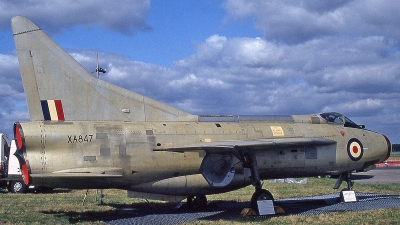
 Random great photos of the English Electric Lightning P1B:
Random great photos of the English Electric Lightning P1B:
